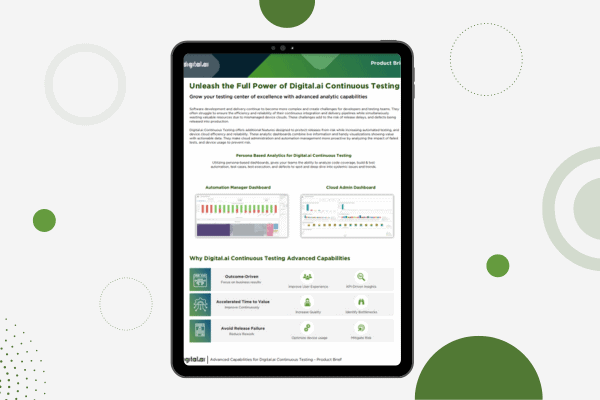What is Cross Browser Testing?
Explore the importance, methodologies, tools, best practices, challenges, and trends of Cross Browser Testing to optimize user experience.
Table of Contents
Cross-browser testing (cross browser testing, Cross-Browser Testing) is an important process in web development. It safeguards the flawless operation and visual consistency of websites across a vast multitude of browsers. The mobile world is fragmented especially from an Android perspective where device models, and OS versions vary wildly. Cross-browser testing embodies the concept of ensuring a smooth and satisfying experience for all users, regardless of their browser or device.
In essence, it entails meticulously examining a website on various browsers and devices to identify and rectify any inconsistencies that might arise. This could involve anything from ensuring that the layout renders correctly across different screen sizes to verifying that buttons and forms function flawlessly on all browsers. Proactively conducting thorough cross-browser testing, helps developers prevent user frustration and ensure a positive experience for everyone who visits their website.
Importance of Cross Browser Testing
Cross-browser testing safeguards a flawless user experience across all browsers, maximizing website effectiveness and brand reputation. The main factors of importance are:
Optimizing User Experience and Conversion Rates
In today’s competitive online landscape, a seamless user experience across all browsers is paramount. Cross-browser testing helps ensure consistent functionality and a positive user experience, ultimately leading to higher conversion rates and increased business value.
Enhancing Brand Reputation and Credibility
A website riddled with browser inconsistencies is unprofessional and will deter potential customers. Cross-browser testing ensures a polished and consistent user experience across all platforms, fostering trust and building brand credibility. Delivering a high-quality experience regardless of browser choice, projects a professional image and inspires brand confidence.
Maximizing Efficiency and Cost Savings
Cross-browser testing conducted early in the development lifecycle helps identify and rectify compatibility issues before they become expensive problems. Catching bugs early on saves valuable development resources and prevents the need for costly rework later in the process. Proactively addressing browser compatibility, optimizes development efficiency and minimizes the cost of projects.
Boosting Search Engine Visibility and Organic Traffic
Search engines like Google consider website responsiveness across various browsers as a ranking factor. Websites that display well and function flawlessly across all browsers are more likely to rank higher in search results. Cross-browser testing contributes to improved SEO (Search Engine Optimization), leading to increased organic traffic and enhanced online visibility for businesses.
In essence, cross-browser testing is a strategic investment that delivers tangible benefits. It fosters a positive user experience, strengthens brand reputation, improves development efficiency, and ultimately drives business growth.
Understanding the Risks of Inconsistent Browsers: A Business Perspective
Cross-browser incompatibility arises from a confluence of factors:
- Rendering Engine Disparity: Each browser employs its own “engine” to translate and display webpages. This can lead to inconsistencies in how layouts, fonts, and even animations are presented, potentially creating a confusing experience for users.
- Standards with Nuances: While web development has standardized languages like HTML and CSS, browsers may interpret them with slight variations. These subtle differences can manifest as inconsistencies across different platforms.
- Legacy Browser Support: Maintaining compatibility with older browsers can be a challenge, as they may not support newer technologies. This can force businesses to choose between supporting a wider user base or leveraging cutting-edge features.
These factors combine to negatively impact user experience in several ways:
- Visual Inconsistencies: Broken layouts, misaligned elements, or incorrect fonts make websites look unprofessional and deters potential customers.
- Functionality Issues: Buttons that don’t work, forms that malfunction, or interactive elements that don’t respond can significantly hinder user engagement and potentially lead to lost conversions.
- Accessibility Concerns: If a website isn’t compatible with assistive technologies like screen readers, a significant portion of the potential user base, will be excluded, hindering inclusivity and brand reputation.
By understanding the root causes and potential consequences of cross-browser incompatibility, businesses can make informed decisions about their website’s development and testing strategy.
Streamlining Cross-Browser Testing to Achieve Efficiency and Scalability
Cross-browser testing encompasses a range of methodologies tailored to optimize the process based on project scope and resources:
Manual Testing
Manual Testing involves manually accessing your website on various browsers and devices to identify inconsistencies. While thorough and ideal for pinpointing specific edge cases, it can be time-consuming and impractical for large websites with frequent updates.
Automated Testing Cross-browser testing tools
Leverage automation to streamline the process. These tools allow pre-defined tests to be run across a multitude of browser and device configurations simultaneously. This significantly reduces testing time and effort, making it ideal for large-scale websites with frequent deployments.
Mobile-Specific Testing
With the explosion of mobile web usage, testing websites across various mobile browsers and devices becomes crucial. Mobile browsers may have different rendering capabilities and user interaction methods compared to desktop browsers. A dedicated mobile testing strategy ensures a seamless experience across all screen sizes and platforms.
Cross Browser Testing Tools
A vast array of cross-browser testing tools are available to assist developers in their testing endeavors. Here’s a brief overview of some popular options:
- Digital.ai: Runs unlimited parallel tests securely on a large matrix of real devices and browsers located in globally distributed data centers.
- BrowserStack: Offers a cloud-based platform for testing across a vast range of browser and device combinations.
- Sauce Labs: Provides a similar cloud-based solution for cross-browser testing with real device access.
- Selenium: An open-source framework enabling developers to create custom automated tests.
Choosing the right tool depends on specific needs and budget. Consider factors like the number of browsers and devices you need to support, the level of automation desired, and the integration with the existing development workflow.
How to Choose the Right Tool?
The ideal cross-browser testing tool depends on specific organizational needs and budget. Consider factors like the number of browsers and devices needed to support, the level of automation desired, and the integration with the existing development workflow.
Cross-Browser Testing Best Practices for Maximum Impact
Effective cross-browser testing hinges on implementing these key best practices:
- Strategic Test Planning: Defining clear testing goals, target browsers, devices, and overall scope at the outset is crucial. This prioritizes efforts, ensures a comprehensive testing process, and avoids wasted resources.
- Data-Driven Targeting: Understanding the target audience is paramount. Leverage user analytics data to identify the browsers and devices most used by customers. Focus testing efforts on these priority platforms to maximize impact and ensure a seamless experience for the users who matter most.
- Automation for Efficiency: While manual testing remains valuable for identifying unique edge cases, automated testing should be heavily leveraged. Cross-browser testing tools automate repetitive tasks, significantly reducing testing time and effort. This frees up developer resources for more strategic initiatives.
Adopting these best practices, helps businesses establish cost-effective and efficient cross-browser testing strategies that guarantee a positive user experience across all relevant browsers and devices. This, in turn, fosters brand loyalty, boosts user engagement, and ultimately drives business growth.
Challenges in Cross-Browser Testing
Cross-browser testing presents several challenges that developers need to be aware of:
- Browser Quirks: Even with standardized code, slight variations in how browsers interpret and display information can cause inconsistencies. Developers need to adapt by fine-tuning code or employing techniques to identify specific browsers for adjustments.
- Device Diversity: The multitude of mobile devices with varying screen sizes demands testing websites for responsiveness and optimal viewing on all platforms. Implementing responsive design principles is crucial to guarantee a smooth user experience across all devices.
- Test Case Upkeep: As websites grow and features evolve, maintaining a robust suite of test cases is a challenge. Developers should prioritize writing clear and reusable tests to minimize the effort required to keep them up-to-date.
- Cloud Testing Considerations: While cloud-based testing tools offer significant benefits, they may have limitations like potential network delays or restricted access to specific browser versions. Developers need to weigh these factors when choosing a cloud solution.
- Headless Browser Testing Trade-offs: Running automated tests without a visual interface (headless testing) is efficient but can miss visual inconsistencies detectable in manual testing. Combining headless and traditional browser testing provides a more comprehensive testing approach.
By understanding these challenges, developers can implement effective strategies to ensure their websites function flawlessly across all browsers and devices, ultimately delivering a positive user experience for everyone.
The Future of Cross-Browser Testing: Trends Shaping the Landscape
The world of cross-browser testing is in constant flux, adapting to the ever-changing tech landscape. Here’s a glimpse into some of the key trends shaping the future of this crucial software development practice:
Rise of Headless Testing
Headless browser testing, where automation scripts run without a graphical interface, is rapidly gaining traction. This method boasts impressive speed and efficiency, allowing for faster test execution and seamless integration into CI/CD pipelines. Essentially, it allows developers to catch bugs earlier and get features out the door quicker.
Mobile First Mentality
With mobile web usage surpassing desktop usage, the focus on mobile-specific cross-browser testing strategies is paramount. Testing tools are evolving to cater to the unique needs of mobile devices, ensuring websites render flawlessly and deliver an optimal user experience on various screen sizes and operating systems.
Developer-Centric Approach
Cross-browser testing tools are no longer isolated entities. The trend is towards tighter integration with popular development tools and frameworks. This streamlines the testing process for developers by allowing them to test directly within their familiar workflows, eliminating context switching and improving overall efficiency.
Focus on Visual Testing
Visual testing tools that leverage image comparison techniques are gaining popularity. These tools go beyond functionality to ensure a website’s visual appearance remains consistent across different browsers. This is particularly important for maintaining brand identity and user experience across platforms.
Staying informed about these trends, allows developers and businesses to leverage the latest advancements in cross-browser testing to deliver high-quality, visually appealing, and user-friendly web experiences across all devices and browsers.
Conclusion
In today’s digital world, where users access websites from a vast array of devices and browsers, ensuring a seamless user experience (UX) is paramount for business success. Cross-browser testing emerges as a critical weapon in this battle for user satisfaction. By embracing this practice, businesses can:
Guarantee User Experience Consistency
Consistent performance across all browsers and devices builds trust and keeps users engaged. Imagine a potential customer encountering a layout glitch or a broken feature simply because they’re using a specific browser. Cross-browser testing eliminates these inconsistencies, ensuring a smooth and positive experience for everyone.
Mitigate Risk and Drive Revenue
A website riddled with browser-specific issues can lead to lost sales and frustrated users. Cross-browser testing minimizes these risks, protecting brand reputation and driving conversions. Ensuring a flawless experience across all platforms, removes barriers to entry for potential customers.
Optimize Development Efficiency
Modern cross-browser testing tools integrate seamlessly with development workflows, allowing for faster testing cycles and quicker identification of bugs. This translates to faster development times and quicker time-to-market for new features and functionalities.
Cross-browser testing is no longer a nice-to-have, but a business imperative. Investing in this practice, gives businesses a high-quality website that delivers a consistent and positive user experience across all devices and browsers, ultimately driving customer satisfaction and business growth.




